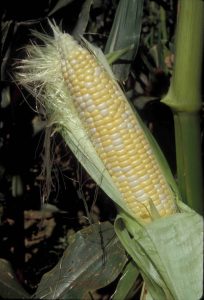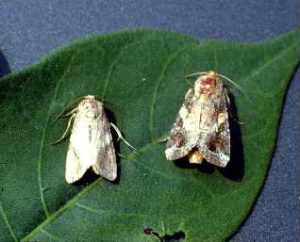Sweet Corn IPM Newsletter No. 8 – August 30, 2019

Sweet Corn IPM Newsletter No. 8 – August 30, 2019
Click on photos to enlarge.
Last Issue for the 2019 Season
VERY HIGH CORN EARWORM PRESSURE CONTINUES
All Fresh Silking Corn Remaining Requires Protection
This will be the final issue of the Sweet Corn IPM Newsletter for the 2019 season. I would like to thank all of the growers who participated in the program this year, and our team of IPM scouts, including Lindsey Ridlon, Althea Hicks and Sean McAuley.
SITUATION
With the holiday weekend approaching, sweet corn supply and quality look very good. Continued good growing weather has hastened maturity of late season plantings and, unfortunately, encouraged insect infestations; meaning some locations are now facing the highest pressure of the season from corn earworm. Extended forecasts suggest the insect pressure will remain high for the near future.
European corn borer: There was very low moth activity this week; only one site in Sabattus was over the five moth per week threshold for silking corn. Feeding injury by larvae on pre-tassel corn was also low, with no fields exceeding the 15% control threshold.
Corn earworm: Moth counts increased significantly at most locations this week, with the exception of the most northern sites. A six-day spray schedule for all silking corn was recommended for Sabattus. A five-day spray schedule was recommended in Oxford. A four-day spray schedule was recommended in Auburn, Biddeford, Bowdoinham, Charleston, one Dayton site, Lewiston, Monmouth, Nobleboro, Sabattus, Wayne and Wells. A three-day spray interval was recommended in Cape Elizabeth, North Berwick, and one Dayton site.
- Corn Earworm Moth; photo by David Handley
- Fall Armyworm Moths (female right, male left); photo by James Dill
Fall armyworm: Moth counts were over the 3-moth threshold for silking corn in Bowdoinham, Cape Elizabeth, Dayton, Lewiston, Monmouth, Nobleboro, Oxford, Sabattus, Wayne and one Wells site; but all sites were also under a spray interval for corn earworm, so no additional controls should be needed for fall armyworm. Larval feeding damage was over the 15% spray threshold in Bowdoinham this week.
Western bean cutworm: Moth counts fell significantly this week, with many sites catching none, and only two sites, in Dayton and Wells, exceeding the suggested three moth per week threshold for silking corn; but both sites should be protected by recommended sprays for corn earworm.
- Corn Field Plowed Down; photo by David Handley
- Oats Cover Crop; photo by David Handley
Annual end of corn season checklist:
- Plow down corn stalks and stubble to destroy overwintering larvae of European corn borer.
- Plant a cover crop, such as winter rye, to prevent soil erosion and to add organic matter to the soil.
- Take a soil test to determine if lime or other nutrients should be applied.
- Plan to rotate your crops to prevent pests from building up in any one location.
The New England Vegetable & Fruit Conference will be held in Manchester, NH December 10, 11, 12, 2019. Program and registration information will be coming soon. Click here to visit the event website.
Sincerely,
David T. Handley
Vegetable and Small Fruit Specialist
Highmoor Farm UMaine Extension Diagnostic
P.O. Box 179 Research Lab, Pest Mgmt. Unit
52 U.S. Route 202 17 Godfrey Drive
Monmouth, ME 04259 Orono, ME 04473
207.933.2100 1.800.287.0279
| Location | CEW Moths |
ECB Moths |
FAW Moths |
WBC Moths |
Feeding Damage |
Recommendations / Comments |
|---|---|---|---|---|---|---|
| Auburn | 24 | 0 | 1 | 0 | 4-day spray interval for all silking corn | |
| Biddeford | 57 | 0 | 8% | 4-day spray interval for silking corn | ||
| Bowdoinham | 11 | 1 | 6 | 0 | 31% | 4-day spray interval for all silking corn |
| Cape Elizabeth I | 148 | 0 | 24 | 0 | 3-day spray interval for silking corn | |
| Cape Elizabeth II | 137 | 0 | 28 | 0 | 9% | 3-day spray interval for silking corn |
| Charleston | 23 | 3 | 0 | 0% | 4-day spray interval for all silking corn | |
| Dayton I | 35 | 0 | 7 | 0 | 4-day spray interval for silking corn | |
| Dayton II | 100 | 1 | 2 | 6 | 3-day spray interval for silking corn | |
| Lewiston | 65 | 0 | 6 | 0 | 4-day spray interval for all silking corn | |
| Levant | 1 | 3 | 0 | 1% | No spray recommended | |
| Monmouth | 14 | 0 | 32 | 4-day spray interval for all silking corn | ||
| Nobleboro | 35 | 0 | 15 | 2 | 5% | 4-day spray interval for all silking corn |
| North Berwick | 115 | 0 | 3 | 1 | 3-day spray interval for silking corn | |
| Oxford | 6 | 0 | 4 | 0 | 5-day spray interval for all silking corn | |
| Palmyra | 1 | 2 | 0 | 1% | No spray recommended | |
| Sabattus | 2 | 5 | 7 | 0 | 6-day spray interval for all silking corn | |
| Wayne | 12 | 0 | 8 | 4-day spray interval for all silking corn | ||
| Wells I | 8 | 0 | 0 | 0 | 4-day spray interval for all silking corn | |
| Wells II | 65 | 0 | 16 | 5 | 4-day spray interval for all silking corn |
CEW: Corn earworm (Only fresh silking corn should be sprayed for this insect.)
ECB: European corn borer
FAW: Fall armyworm
WBC: Western bean cutworm
Corn Earworm Spray Thresholds for Pheromone Traps
| Moths caught per week | Moths caught per night | Spray interval |
|---|---|---|
| 0.0 to 1.4 | 0.0 to 0.2 | No spray |
| 1.5 to 3.5 | 0.3 to 0.5 | Spray every 6 days |
| 3.6 to 7.0 | 0.6 to 1.0 | Spray every 5 days |
| 7.1 to 91 | 1.1 to 13.0 | Spray every 4 days |
| More than 91 | More than 13 | Spray every 3 days |
Thresholds apply only to corn with exposed fresh silk. Lengthen spray intervals by one day if maximum daily temperature is less than 80°F.
European Corn Borer Thresholds
Whorl stage: 30% or more of plants scouted show injury.
Pre-tassel-silk: 15% or more of plants scouted show injury.
Silk: 5 or more moths caught in pheromone traps in one week.
IPM Web Pages:
UMaine Cooperative Extension Integrated Pest Management
Penn State Pest Watch – Sweet Corn
UMass Amherst Integrated Pest Management
Where brand names or company names are used, it is for the reader’s information. No endorsement is implied nor is any discrimination intended against other products with similar ingredients. Always consult product labels for rates, application instructions and safety precautions. Users of these products assume all associated risks.
The University of Maine is an equal opportunity/affirmative action institution.




